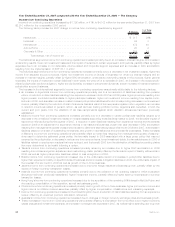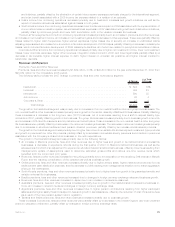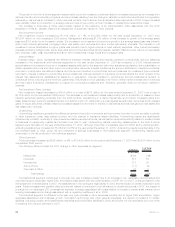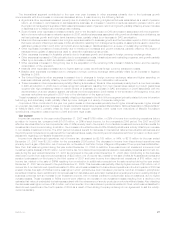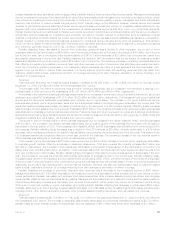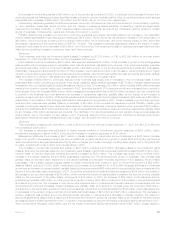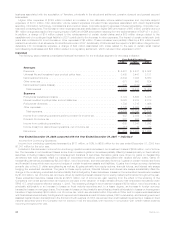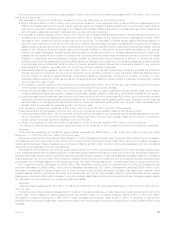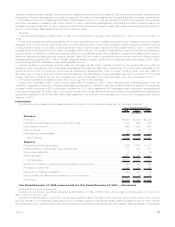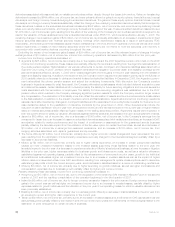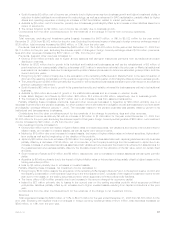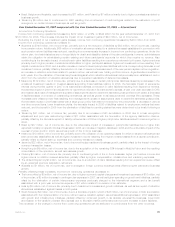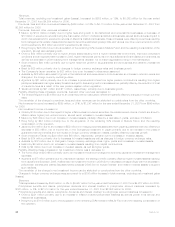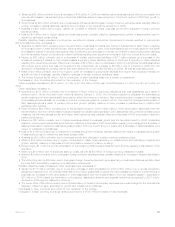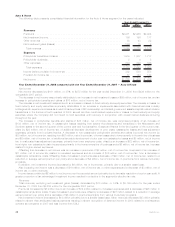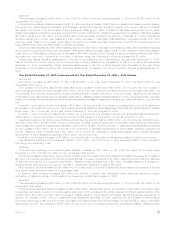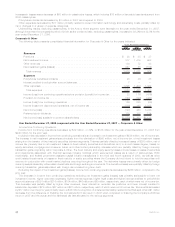MetLife 2008 Annual Report Download - page 37
Download and view the complete annual report
Please find page 37 of the 2008 MetLife annual report below. You can navigate through the pages in the report by either clicking on the pages listed below, or by using the keyword search tool below to find specific information within the annual report.Interest credited to policyholder account balances increased by $15 million. Interest credited on the general account portion of
investment-type products decreased by $40 million, while other businesses decreased by $5 million. Of the $40 million decrease on the
general account portion of investment-type products, management attributed $68 million to lower crediting rates partially offset by a
$28 million increase due to higher average general account balances. More than offsetting these decreases was lower amortization of the
excess interest reserves on acquired annuity and universal life blocks of business of $60 million primarily driven by lower lapses in the
current year.
Policyholder dividends increased by $24 million due to growth in the business.
Higher other expenses of $1,140 million include higher DAC amortization of $1,287 million primarily relating to lower expected future
gross profits due to separate account balance decreases resulting from recent market declines, higher net investment gains primarily due
to net derivative gains and the reduction in expected cumulative earnings of the closed block partially offset by a reduction in actual
earnings of the closed block and changes in assumptions used to estimate future gross profits and margins. This was offset by a decrease
in other expenses of $147 million driven by a $149 million decrease in non-deferrable volume related expenses, which include those
expenses associated with information technology, compensation and direct departmental spending. Direct departmental spending
includes expenses associated with consultants, travel, printing and postage. Additionally, there was a decrease due to a $24 million
write-off of a receivable from one of the Company’s joint venture partners in the prior year. Partially offsetting these decreases was an
increase of $26 million due to the impact of revisions to certain pension and post retirement liabilities in the current year.
Year Ended December 31, 2007 compared with the Year Ended December 31, 2006 — Individual
Income from Continuing Operations
Income from continuing operations increased by $99 million, or 8%, to $1,341 million for the year ended December 31, 2007 from
$1,242 million for the comparable period in 2006. Included in this increase was a decrease in net investment losses of $311 million, net of
income tax. Excluding the impact of net investment gains (losses), income from continuing operations decreased by $212 million from
2006.
Thedecreaseinincomefromcontinuingoperationsfortheyearwasdrivenbythefollowingitems:
• Higher DAC amortization of $205 million, net of income tax, primarily resulting from business growth, lower net investment losses in
2007 and revisions to management’s assumptions used to determine estimated gross profits and margins.
• Unfavorable underwriting results in life products of $151 million, net of income tax. Underwriting results are generally the difference
between the portion of premium and fee income intended to cover mortality, morbidity or other insurance costs less claims incurred
and the change in insurance-related liabilities. Underwriting results are significantly influenced by mortality, morbidity, or other
insurance-related experience trends, as well as the reinsurance activity related to certain blocks of business. Consequently, results
can fluctuate from year to year.
• Higher expenses of $132 million, net of income tax. Higher general expenses, the impact of revisions to certain liabilities in both
years, and the write-off of a receivable from one of the Company’s joint venture partners contributed to the increase in other
expenses.
• An increase in the closed block-related policyholder dividend obligation of $75 million, net of income tax, which was driven by net
investment gains.
• Higher annuity benefits of $24 million, net of income tax, primarily due to higher amortization of deferred costs, partially offset by lower
costs of guaranteed annuity benefit riders and related hedging.
• An increase in policyholder dividends of $12 million, net of income tax, due to growth in the business.
• An increase in interest credited to policyholder account balances of $13 million, net of income tax, due primarily to lower amortization
of the excess interest reserves on acquired annuity and universal life blocks of business.
These aforementioned decreases in income from continuing operations were partially offset by the following items:
• Higher fee income from separate account products of $276 million, net of income tax, primarily related to fees being earned on a
higher average account balance resulting from a combination of growth in the business and overall market performance.
• Higher net investment income on blocks of business not driven by interest margins of $99 million, net of income tax, due to an
increase in yields and growth in the average asset base.
• An increase in interest margins of $18 million, net of income tax. Interest margins relate primarily to the general account portion of
investment-type products. Management attributed a $1 million decrease to the deferred annuity business offset by a $19 million
increase to other investment-type products, both net of income tax. Interest margin is the difference between interest earned and
interest credited to policyholder account balances related to the general account on these businesses. Interest earned approximates
net investment income on invested assets attributed to these businesses with net adjustments for other non-policyholder elements.
Interest credited approximates the amount recorded in interest credited to policyholder account balances. Interest credited to
policyholder account balances is subject to contractual terms, including some minimum guarantees, and may reflect actions by
management to respond to competitive pressures. Interest credited to policyholder account balances tends to move in a manner
similar to market interest rate movements, and may reflect actions by management to respond to competitive pressures and,
therefore, generally does not, but it may, introduce volatility in expense.
The change in effective tax rates between years accounts for the remainder of the decrease in income from continuing operations.
Revenues
Total revenues, excluding net investment gains (losses), increased by $527 million, or 4%, to $15,547 million for the year ended
December 31, 2007 from $15,020 million for 2006.
Premiums decreased by $21 million due to a decrease in immediate annuity premiums of $27 million, and an $89 million decline in
premiums associated with the Company’s closed block of business, in line with expectations. These decreases were partially offset by
growth in premiums from other life products of $95 million, primarily driven by increased sales of term life business.
Universal life and investment-type product policy fees combined with other revenues increased by $386 million due to a combination of
growth in the business and improved overall market performance, as well as revisions to management’s assumptions used to determine
34 MetLife, Inc.


